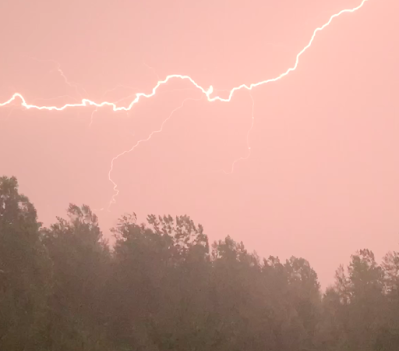Lightning activity, or the lack thereof, can tell us where droughts are developing, where droughts are ending and where severe weather is moving, changing or just being weird.
A weather and environmental monitoring company called Vaisala Xweather compiled an analysis of lightning in the United States in 2022 into an annual report, something the company has done since at least 2015.
Vaisala said lightning zapped in the United States a total of more than 198 million times in 2022. The state with the most strikes was Texas, with just under 30 million.
As the Washington Post reports:
"Recently released U.S. lightning data by weather and environmental monitoring company Vaisala Xweather showed portions of the Midwest and Texas - typical lightning hot spots - had a weaker display of activity in 2022 compared to its recent average. The lack of lightning was a signal itself of atypical weather across the country last year, including major drought across the Mississippi River basin."
The Washington Post explains why lightning data is important:
"Lightning detection is like measuring a person's reflexes: The system can appear normal overall, but certain areas may show more signs of struggle than others. That's what happened in 2022. After back to back years of concerning low activity in 2021 and 2020, the total number of lightning strikes was closer to average. Still, pockets of the country showed record low or high activity in ways that left researchers surprised."
Lightning was below average in the Mississippi River basin. Which is bad, because that area receives about half its annual rainfall from thunderstorms. It was the third consecutive year with below average lightning activity in that region.
The Mississippi River fell to nearly record low levels in the autumn. Simply measuring rainfall is of course the obvious way to figure out whether you're in a drought. But lightning data can help show what type of rainfall was lacking.
The dearth of lightning meant that the downpours usually associated with thunderstorms was lacking. Since torrential rains are more likely to flow into rivers, that provides more evidence as to why the Mississippi was so low.
Other areas had a lot of lightning.
Florida, due to its geography and climate gets zapped with tons of lightning strikes each year. However, 2022 was an especially busy year for lightning in Florida. They had 33 percent more lightning compared with the 2015-2021 average, says WaPo
Part of the problem was Hurricane Ian, that intense storm that caused $60 billion in damage.
Hurricanes don't usually produce all that much lightning, but this one did. At its peak, it was producing lightning every three seconds in the hurricane's eyewall.
The eyewall is a circle of especially intense winds surrounding the calm eye of a hurricane.
Most of the extra lightning strikes across Florida, though, were just due to a busy summer thunderstorm season that was even more active than usual.
Another state that saw an increase in lightning over previous years was Arizona. In mid to late summer, humid winds from the Gulf of Mexico and the Pacific Ocean are drawn toward Arizona by low pressure created by summer heat.
That creates what is known as a monsoon season, in which thunderstorms frequently erupt in the Desert Southwest. Contrary to recent years, the Arizona monsoon season was more active than usual
Another very weird lightning hot spot was around Buffalo, New York during their epic Christmas lake effect blizzard. A good 1,0000 lightning strikes were detected during the blizzard over three and a half days, which is more lightning than anyone can recall in such a weather pattern.
Climate change is blamed for just about everything that goes wrong in the weather and elsewhere. However, so far at least, there are no discernible overall trends in lightning frequency in the United States because of climate change.
VERMONT LIGHTNING
Here in Vermont, we don't have a lot of lightning, compared to many other places east of the Rocky Mountains.
Given the Green Mountain State's relatively small size and fairly low level of thunderstorm activity, we had the four least amount of lightning of all the states and the District of Columbia.
Vaisala detected 62,954 lightning strikes in Vermont during 2022. Only Rhode Island, Hawaii, and the District of Columbia had less lightning during the year.
Overall, lightning activity during 2022 in Vermont was near or a little below average. In 2021 Vermont saw 71,264 lightning strikes.
Maybe a better way to measure how Vermont and other states rank is lightning density, which Vaisala defines as events per square kilometer. Measured that way, Vermont ranked 43rd in the nation in terms of lightning density.
For fun, Vaisala nominates the lightning capitals of each state. It's where lightning was detected the most. In Vermont, this year's lightning capital was Danby. In 2021, Vermont's lightning capital was Ripton. So you see it's pretty random.
Speaking of random, it's interesting that the highest lightning density in Vermont in 2021 was in central parts of the state, with less north and south. In 2022, it was just the opposite, with somewhat higher lightning density south and north, with lesser amounts in central Vermont.


No comments:
Post a Comment